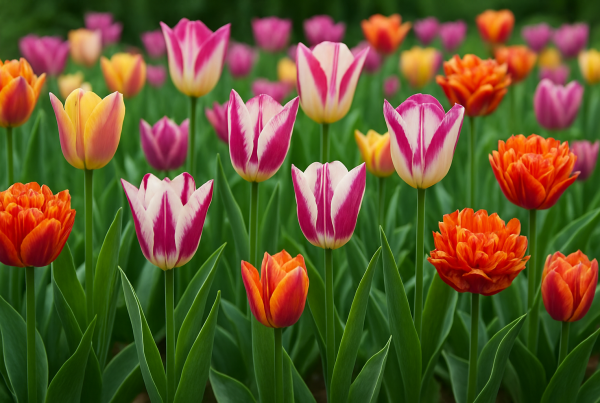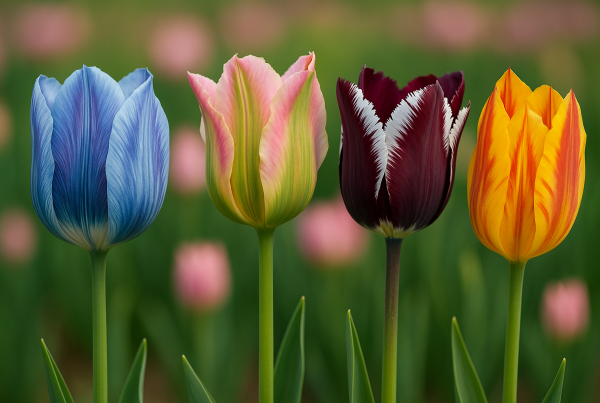Tulips, with their vibrant colors and elegant shapes, have captivated gardeners and flower enthusiasts for centuries. As one of the most beloved spring flowers, they offer a dazzling array of varieties that can transform any modern garden into a vibrant tapestry of hues. Whether you’re a seasoned horticulturist or a beginner eager to dive into the world of gardening, understanding the essentials of tulip care is key to enjoying these beautiful blooms. In this guide, we’ll explore the diverse tulip varieties, share expert gardening tips for planting tulips, and provide insights into nurturing these colorful tulips to ensure a spectacular seasonal display. Join us on this exciting journey and discover how to infuse your outdoor space with the magic of tulips.
Understanding Tulip Varieties
Exploring Diverse Tulip Types
Tulips come in a remarkable range of types, each offering unique beauty and charm to modern gardens. Single Early Tulips are known for their classic, simple blooms, perfect for early spring displays. Double Tulips resemble peonies, with multiple layers of petals creating a lush appearance. Darwin Hybrid Tulips are loved for their large, robust flowers and strong stems, making them ideal for both garden displays and cut flowers. Parrot Tulips stand out with their exotic, fringed petals and stunning color variations, adding a touch of drama to any garden setting.
Here is an example of the vivid colors and forms these tulips can display:

Each type has its own planting and care requirements, but all tulips thrive in well-drained soil and sunny spots. Choosing the right variety can transform your garden into a vibrant tapestry of color in spring.
Choosing Tulips for Your Garden
Selecting the right tulips for your garden involves considering several factors to ensure a stunning spring display. First, think about bloom time. Single Early Tulips bloom at the start of spring, setting the stage for a season of color. Next, consider the visual impact. Double Tulips offer lush, peony-like flowers, ideal for those seeking dramatic beauty. Darwin Hybrid Tulips are perfect if you’re looking for height and robust blooms that stand out.
Additionally, assess your garden’s conditions. Tulips flourish in well-drained soil and sunny locations. Ensure the chosen varieties match these conditions for optimal growth. Don’t forget color combinations—mixing different tulip types can create a dynamic and visually appealing garden.
Here’s a glimpse of how tulips can enhance your garden’s beauty:

Whether you prefer classic elegance or vibrant exuberance, there’s a tulip variety to suit every garden style.
Planting Tulips Made Easy
Best Time to Plant Tulips
Timing is crucial for planting tulips to ensure a vibrant spring display. The ideal period is in the fall, specifically 6 to 8 weeks before the first hard frost. This timing allows the bulbs to establish roots before winter sets in, ensuring they are ready to bloom when spring arrives. In most regions, this means planting from late September to early November.
Planting too early when the soil is warm can lead to disease and bulb rot. Conversely, planting too late might not give the bulbs enough time to develop robust root systems. If you’re in a warmer climate, pre-chilling the bulbs for several weeks before planting can mimic the cold dormancy they need.
Here’s a visual to inspire your planning:

By planting at the right time, you set the stage for a successful and colorful tulip season.
Step-by-Step Planting Guide
Planting tulips is straightforward with the right approach. Follow this step-by-step guide for a successful start:
- Choose a Location: Select a sunny spot with well-drained soil. Tulips thrive in areas that receive full sun or partial shade.
- Prepare the Soil: Improve drainage by mixing in compost or sand, especially if the soil is heavy or clay-like.
- Planting Depth: Dig holes 6 to 8 inches deep. This depth protects the bulbs from cold temperatures and pests.
- Positioning the Bulbs: Place the bulbs in the hole with the pointed end facing up. This ensures proper growth direction.
- Spacing: Space bulbs 4 to 6 inches apart to allow room for growth and air circulation.
- Watering: Water the bulbs thoroughly after planting to help settle the soil and promote root development.
By following these simple steps, your tulips will have the best chance to flourish and bring vibrant color to your garden.
Essential Tulip Care Tips
Watering and Fertilization
Proper watering and fertilization are key elements of tulip care. Right after planting, it’s important to water the bulbs thoroughly to help them settle into the soil. During the growing season, water moderately. Ensure the soil is moist but not waterlogged, as excessive moisture can lead to bulb rot. It’s best to water early in the morning, allowing excess moisture to evaporate by evening.
For fertilization, start with a slow-release bulb fertilizer when planting in the fall to provide essential nutrients as the bulbs develop roots. In early spring, as new growth begins, apply a balanced fertilizer, such as a 10-10-10 formula, to support healthy blooms.
Avoid fertilizing after the blooming period, as tulips don’t require additional nutrients then. With proper watering and fertilization, your tulips will thrive, showcasing their vibrant and colorful blooms in your garden.
Protecting Tulips from Pests
Protecting tulips from pests is crucial for maintaining their health and ensuring a beautiful spring bloom. Common pests include deer and rodents, which can dig up and eat the bulbs. To deter these animals, consider laying a wire mesh over the planting area. This physical barrier can prevent digging while allowing the tulips to grow unhindered.
Additionally, planting strong-smelling plants, such as garlic or daffodils, around your tulips can help deter pests due to their unpleasant scent.
Insect pests like aphids might also target tulips. Regularly inspect your plants and, if needed, use insecticidal soap or neem oil to manage infestations.
Maintaining a clean garden by removing fallen leaves and debris can minimize hiding spots for pests. By employing these strategies, you can effectively protect your tulips, ensuring their vibrant presence in your garden each spring.







